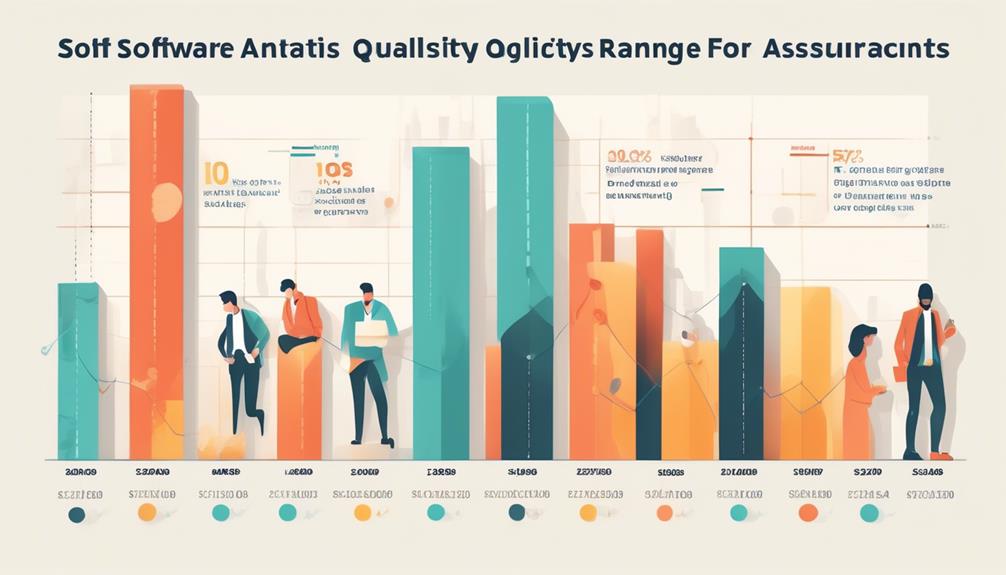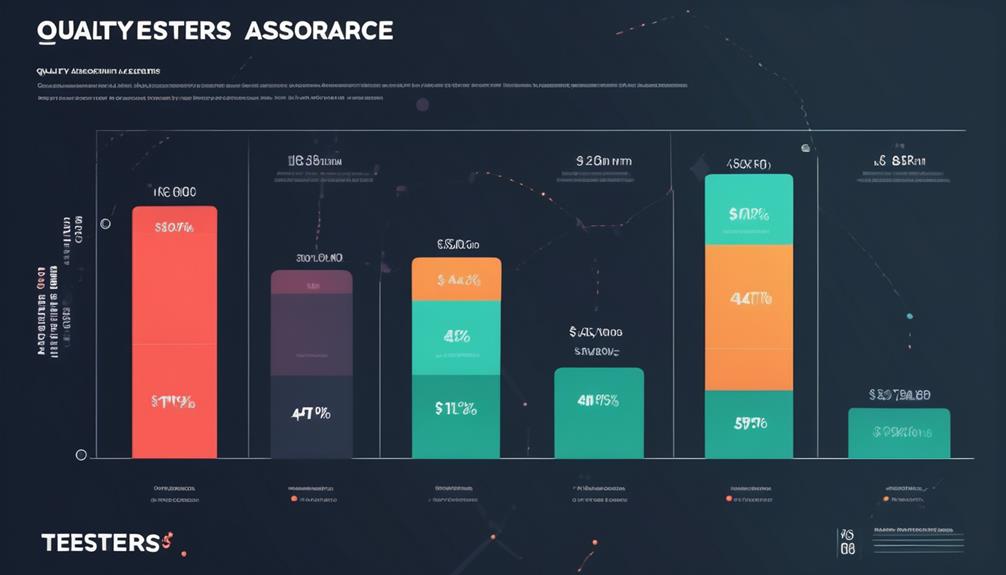SQA Techniques and Tools
Essential SQA Testing Techniques Explained

Welcome to our comprehensive guide on SQA testing techniques! For those engaged in software development, testing, or quality assurance, understanding these strategies is crucial for ensuring software quality and securing customer satisfaction.
Software testing techniques are diverse and encompass a range of methodologies to evaluate software applications. By employing these techniques, organizations can identify defects and improve the overall software quality. Let’s explore some of the key testing techniques used in software quality assurance.
Key Takeaways:
- Software testing techniques are essential for evaluating software applications.
- Common testing techniques include manual and automated testing, functional and non-functional testing, unit testing, integration testing, and more.
- Static testing techniques focus on finding defects without executing the code, while dynamic testing techniques involve executing the code to test software behavior.
- Functional and non-functional testing techniques assess different aspects of software requirements and performance.
- Black box, white box, and gray box testing techniques provide different perspectives on testing software functionality and internal structure.
Principles of Testing
When it comes to software testing, there are certain principles that we follow to ensure the effectiveness of our testing efforts. These principles not only help us meet customer requirements but also contribute to achieving software quality. Let’s take a closer look at these guiding principles:
1. Meeting Customer Requirements
At the core of our testing efforts is the aim to meet customer requirements. By understanding and aligning with the needs of our customers, we can design tests that accurately evaluate whether the software meets their expectations.
2. Involving Third-Party Testing
Third-party testing plays a crucial role in ensuring an unbiased evaluation of the software. By involving external testers, we gain valuable insights and perspectives that can uncover potential issues and improve software quality.
3. Conducting Planned Tests
Testing should be a planned and structured activity. By establishing clear test objectives and designing comprehensive test plans, we can ensure thorough coverage of the software and increase the likelihood of identifying defects.
4. Performing Optimal Testing Based on Risk Assessment
Not all parts of the software carry the same level of risk. By conducting risk assessments, we can prioritize our testing efforts and focus on the areas that are most critical to software quality. This allows us to allocate resources efficiently and mitigate potential risks.
5. Following the Pareto Rule
The Pareto principle, also known as the 80/20 rule, states that 80% of defects are usually caused by 20% of the software components. By identifying and addressing these critical areas, we can make significant improvements in software quality.
6. Starting Testing with Small Parts and Extending to Large Parts
Software testing should start with testing small parts of the system, such as individual functions or modules, before moving on to larger parts, such as integrated systems or end-to-end scenarios. This incremental approach allows us to detect and fix defects early, leading to improved software quality.
“Following these principles ensures that our testing efforts are effective and contribute to the overall quality of the software.”

By adhering to these principles, we can maximize the value of our testing efforts and ensure that the software we deliver meets the highest standards of quality. These principles guide us in striving for excellence and continuously improving the quality of our software.
Types of Software Testing Techniques
When it comes to software testing, there are various techniques that can be used to ensure the quality and reliability of applications. These techniques can be broadly categorized into two types: static testing techniques and dynamic testing techniques.
Static Testing Techniques
Static testing techniques are employed to identify defects in software without executing the code. These techniques focus on reviewing and inspecting the software artifacts to find potential issues. Some common static testing techniques include:
- Reviews: Informal peer reviews or formal inspections led by moderators.
- Walkthroughs: The author explains their work to stakeholders, gathering feedback and identifying potential flaws.
- Inspections: Formal and structured reviews performed by a team.
Static analysis is also a part of static testing techniques. It involves examining the code or design to identify defects related to data flow, control flow, and data structure.
Dynamic Testing Techniques
Dynamic testing techniques involve executing the code to test the behavior of the software. These techniques simulate real-world usage scenarios and validate the expected functionality. Some common dynamic testing techniques include:
- Structure-Based Testing: Also known as white box testing, it focuses on analyzing the code structure and ensuring all paths are tested.
- Experience-Based Techniques: These techniques rely on the tester’s experience and knowledge of the application to design effective tests.
- Specification-Based Techniques: These techniques involve testing against specified requirements. Equivalence partitioning and boundary value testing are examples of specification-based techniques.
Combining both static and dynamic testing techniques provides a comprehensive approach to software testing, ensuring that defects are identified and addressed throughout the development lifecycle.

Advantages of Static and Dynamic Testing Techniques
Static testing techniques allow us to catch defects early in the development process, improving overall software quality. They also help in ensuring that the software meets industry standards and compliance requirements. On the other hand, dynamic testing techniques ensure that the software performs as intended and meets user expectations. By executing the code, we can simulate real-world scenarios and validate its behavior. These combined techniques provide a holistic approach to software testing and contribute to delivering high-quality, reliable software products.
| Static Testing Techniques | Dynamic Testing Techniques |
|---|---|
| Reviews: Informal and Formal | Structure-Based Testing: White Box Testing |
| Walkthroughs | Experience-Based Techniques |
| Inspections | Specification-Based Techniques |
| Static Analysis |
Static Testing Techniques
In software development, static testing techniques play a crucial role in ensuring the quality and reliability of software applications. Unlike dynamic testing techniques that involve the execution of code, static testing techniques focus on identifying defects without running the code. This section explores some of the most commonly used static testing techniques, including reviews, inspections, and static analysis.
Reviews
Reviews are a fundamental static testing technique that involves examining software artifacts to find defects and improve overall quality. There are two main types of reviews: informal peer reviews and formal inspections led by moderators.
- Informal peer reviews: In informal peer reviews, team members review each other’s work and provide feedback. This collaborative approach encourages knowledge sharing and helps identify potential issues early in the development process.
- Formal inspections: Formal inspections are structured reviews involving a defined process and specific roles. Led by a moderator, these inspections focus on analyzing software artifacts to uncover defects and ensure compliance with predefined quality standards.
Walkthroughs
Walkthroughs are another static testing technique that involves the author explaining their work to stakeholders. This interactive process allows for a detailed examination of the software artifacts, encouraging feedback and facilitating a shared understanding of the system’s design and functionality. Walkthroughs can be particularly useful in ensuring alignment between the development team and project stakeholders.
Static Analysis
Static analysis is a technique that examines the code or design of a software application to identify defects related to data flow, control flow, and data structure. It involves automated tools that analyze the code without executing it, helping to uncover potential issues and improve overall software quality. Static analysis can provide insights into code complexity, potential security vulnerabilities, and adherence to coding standards.
By leveraging static testing techniques such as reviews, inspections, and static analysis, development teams can significantly enhance the quality of their software applications. These techniques allow for early defect detection, effective collaboration among team members, and adherence to best coding practices.

| Static Testing Techniques | Key Features |
|---|---|
| Reviews | – Informal peer reviews – Formal inspections – Collaboration among team members – Defect identification and improvement of quality |
| Walkthroughs | – Interactive process – Author explaining work to stakeholders – Alignment between development team and project stakeholders – Shared understanding of design and functionality |
| Static Analysis | – Examination of code or design – Identification of defects related to data flow, control flow, and data structure – Use of automated tools – Early defect detection and improvement of overall software quality |
Dynamic Testing Techniques
Dynamic testing techniques are essential for evaluating the behavior of software applications. By executing the code, we can gain valuable insights into its performance, functionality, and adherence to specified requirements. In this section, we will explore three key dynamic testing techniques: structure-based testing, experience-based techniques, and specification-based techniques.
Structure-Based Testing
Structure-based testing, also known as white box testing, focuses on analyzing the code structure to ensure comprehensive test coverage. By understanding the internal workings of the software, we can design tests that target specific code paths and uncover potential defects. A critical aspect of structure-based testing is code coverage analysis, which helps us determine the extent to which the code has been exercised during testing.
Experience-Based Techniques
Experience-based techniques rely on the expertise and knowledge of the tester to conduct effective testing. Drawing from their experience with similar applications, testers can make informed decisions about the most suitable test cases and scenarios. This approach leverages the tester’s intuition and enables them to identify potential issues that may arise based on past experiences.
Specification-Based Techniques
Specification-based techniques involve testing software against predefined requirements or specifications. These techniques ensure that the software meets the desired functionalities and behaves as expected. Two commonly used specification-based techniques are equivalence partitioning and boundary value testing. Equivalence partitioning involves dividing the input data into groups of equivalent values, while boundary value testing focuses on testing the boundaries of these partitions to identify potential errors.
These dynamic testing techniques provide valuable insights into the behavior and functionality of software applications. By combining structure-based, experience-based, and specification-based techniques, we can ensure extensive test coverage and uncover any defects that may compromise software quality.
Functional Testing Techniques
In order to ensure that software meets the functional requirements, various functional testing techniques are employed. These techniques encompass different stages of testing and play a crucial role in delivering a high-quality product.
“Functional testing techniques are essential to validate the functionality of the software and ensure it performs as expected.”
The following functional testing techniques are commonly used:
- Unit Testing: This technique focuses on testing individual units or components of the software. It helps identify any defects in these units and ensures their proper functioning.
- Integration Testing: Integration testing is performed to test the interaction and compatibility of different components when integrated. It helps identify any issues that may arise due to the integration process.
- System Testing: System testing involves testing the complete software system as a whole. It aims to validate that all components work together harmoniously and meet the specified requirements.
- Acceptance Testing: Acceptance testing evaluates the software against customer or end-user expectations. It ensures that the software meets the desired functionality and usability criteria.
By implementing these functional testing techniques, we can uncover any functional defects in the software and ensure that it meets customer requirements. Let’s take a closer look at these techniques and understand how they contribute to software quality.

| Testing Technique | Description |
|---|---|
| Unit Testing | Tests individual units or components |
| Integration Testing | Tests the integration of different components |
| System Testing | Tests the complete software system |
| Acceptance Testing | Tests the software against customer or end-user expectations |
Non-Functional Testing Techniques
When it comes to software testing, there’s more to ensuring quality than just checking if the functionality works as expected. Non-functional testing techniques play a crucial role in evaluating the performance, security, and usability of the software. These tests focus on the aspects that define the user experience and overall satisfaction with the product.
Performance Testing

Performance testing is all about evaluating how well the software performs under various conditions. By simulating different user loads, network speeds, and system configurations, we can identify potential bottlenecks and optimize the software for optimal performance. This is particularly important for applications that need to handle a large number of users or process complex tasks efficiently.
Security Testing
Ensuring the security of software applications is paramount in today’s digital landscape. Security testing techniques help identify vulnerabilities and weaknesses in the software that could be exploited by malicious actors. By conducting comprehensive security tests, we can ensure that the software meets industry standards and complies with security requirements.
Usability Testing
Usability testing focuses on evaluating the user-friendliness and overall user experience of the software. By observing and gathering feedback from real users, we can assess how intuitive the software is, identify areas of improvement, and make necessary adjustments to enhance usability. Usability testing ensures that the software is easy to navigate, understand, and interact with, leading to higher user satisfaction.
| Non-Functional Testing Techniques | Description |
|---|---|
| Performance Testing | Evaluates the software’s performance characteristics under different conditions. |
| Security Testing | Identifies vulnerabilities and ensures compliance with security requirements. |
| Usability Testing | Evaluates the user-friendliness and ease of use of the software. |
By incorporating these non-functional testing techniques into our software testing efforts, we can ensure that the software not only functions correctly but also delivers a seamless user experience. Performance, security, and usability are critical aspects of software quality, and addressing them early on can help us build reliable and user-friendly products.
Black Box Testing Techniques
In the field of software testing, black box testing techniques play a crucial role in evaluating the functionality and reliability of software applications. Unlike white box testing, which examines the internal structure of the software, black box testing focuses on assessing the software’s behavior from an external standpoint. By simulating user interactions, testers can identify potential defects and ensure the software meets customer expectations.
One popular black box testing technique is boundary value testing. This method involves testing at the boundaries of input values, as these boundaries are often where errors and vulnerabilities are most likely to occur. By assessing both the lower and upper limits of acceptable inputs, testers can pinpoint any issues that may arise when input values approach these boundaries. This technique is particularly effective in identifying off-by-one errors and ensuring the stability and robustness of the software.
“Boundary value testing allows us to scrutinize the software’s behavior when it encounters extreme values, enabling us to detect and rectify potential weaknesses. It requires careful consideration of both the valid and invalid inputs to ensure comprehensive testing and enhance software quality.”
Aside from boundary value testing, there are various other black box testing methodologies that enable us to thoroughly assess the software’s functionality. These methodologies include:
- Equivalence partitioning: Dividing the input space into equivalent classes to efficiently test representative values within each class.
- Error guessing: Based on the tester’s experience and intuition, this technique involves predicting and testing potential error-prone areas of the software.
- State transition testing: Focusing on transitions between states, this technique ensures comprehensive testing of software with complex logic and behavior.
- Decision table testing: Analyzing decision rules and their combinations to verify correct software behavior in various scenarios.
Using these black box testing techniques enhances the overall quality and reliability of the software. By evaluating the software’s functionality from an external perspective, we can identify and address defects early in the development lifecycle, reducing the risk of issues being discovered by end-users. This proactive approach ensures that the software meets the desired requirements and delivers a seamless user experience.
White Box Testing Techniques
White box testing techniques are essential in ensuring the quality and reliability of software. By examining the internal structure and behavior of the code, we can identify potential defects and vulnerabilities. One of the key techniques used in white box testing is code coverage analysis, which helps determine the extent to which the code has been exercised during testing.
Code coverage analysis provides valuable insights into the thoroughness and effectiveness of our testing efforts. By measuring code coverage metrics, such as statement coverage, branch coverage, and path coverage, we can assess the completeness of our tests and identify areas that require additional testing. This helps us ensure that all critical code paths and edge cases have been considered.
Dynamic testing, another aspect of white box testing, involves executing the code and observing its behavior. This allows us to validate the expected functionality and identify any discrepancies or deviations. By combining these dynamic testing techniques with code coverage analysis, we can gain a comprehensive understanding of the software’s internal workings.
Code Coverage Metrics
There are various code coverage metrics that can be used to measure the effectiveness of our testing efforts. Some common metrics include:
- Statement Coverage: Measures the percentage of executable statements that have been executed during testing.
- Branch Coverage: Measures the percentage of decision branches that have been exercised during testing.
- Path Coverage: Measures the percentage of unique paths through the code that have been tested.
These metrics provide valuable insights into the areas of the code that require further attention and testing. By striving to achieve high code coverage, we can increase our confidence in the software’s quality and uncover hidden defects.
Benefits of White Box Testing
White box testing techniques, such as code coverage analysis, empower us to gain a deep understanding of the software’s internal behavior. By examining the code at a granular level and executing it with different inputs, we can uncover defects that may go unnoticed with other testing techniques.
Additionally, white box testing allows us to optimize test coverage, ensuring that critical code paths are thoroughly tested. By identifying areas of low code coverage, we can focus our testing efforts, effectively allocating resources and minimizing the risk of undiscovered defects.
White box testing techniques are commonly used in unit testing, integration testing, and system testing. The insights gained from white box testing contribute to overall software quality and enable us to deliver robust and reliable software.
Gray Box Testing Techniques
In the field of software testing, Gray Box Testing Techniques offer a unique approach that combines elements of both black box and white box testing. Gray box testing involves testing the software with partial knowledge of its internal structure, allowing us to gain valuable insights into its behavior and performance. This section explores the key concepts and methodologies behind Gray Box Testing Techniques.
When conducting Gray Box Testing, we have limited knowledge of the internal workings of the software, similar to black box testing. However, unlike black box testing, we do possess some understanding of the internal structure and code, similar to white box testing. This partial knowledge enables us to design effective tests that target specific functionalities, ensuring thorough evaluation of the software’s capabilities.
One of the main advantages of Gray Box Testing Techniques is their ability to identify complex defects that might go unnoticed by other testing methods. By leveraging our partial knowledge of the software’s internal structure, we can uncover potential vulnerabilities, uncover hidden bugs, and ensure a higher level of software quality.
Benefits of Gray Box Testing Techniques:
- Comprehensive Testing: Gray box testing allows us to examine the software from both an external and internal perspective, resulting in more thorough evaluations.
- Efficiency and Effectiveness: By focusing on specific functionalities and leveraging our limited understanding of the internal structure, Gray Box Testing Techniques can optimize testing efforts and identify potential defects efficiently.
- Fault Localization: Gray box testing helps pinpoint the root cause of defects, making it easier to address and resolve issues encountered during the testing process.
Gray Box Testing Techniques combine the advantages of black box and white box testing, offering a unique approach to software evaluation.” – Software Testing Expert
Structure-Based Testing in Gray Box Testing
Within the realm of Gray Box Testing, Structure-Based Testing plays a significant role. This technique focuses on analyzing the internal code structure and ensuring comprehensive test coverage. Structure-Based Testing allows us to evaluate the interaction between different parts of the code, identify potential vulnerabilities, and improve the overall reliability of the software.
Code coverage analysis is a key component of Structure-Based Testing. By examining which parts of the code have been executed during testing, we can ensure adequate test coverage and identify any areas that require further attention. This analysis helps optimize the testing process and enhances the overall effectiveness of Gray Box Testing Techniques.
To illustrate the importance of Structure-Based Testing in Gray Box Testing, consider the following example:
| Testing Technique | Advantages | Disadvantages |
|---|---|---|
| Gray Box Testing with Structure-Based Analysis | Provides detailed insights into code structure, improves test coverage, and identifies potential defects efficiently. | Requires a certain level of understanding of the internal code structure, limiting its applicability in cases with minimal knowledge. |
| Other Gray Box Testing Techniques | Offer diverse testing approaches, but may not provide the same level of code coverage or defect identification. | N/A |
Note: The above table compares the advantages and disadvantages of Gray Box Testing Techniques, emphasizing the benefits of incorporating Structure-Based Testing within the gray box approach.
By utilizing the power of Gray Box Testing Techniques, particularly with a focus on structure-based analysis, we can enhance the effectiveness of our testing efforts and ensure the delivery of high-quality software solutions.
SQA and its Importance
Software quality assurance (SQA) is a crucial step in software development that ensures software meets established quality standards. Our thorough SQA process encompasses the entire software development lifecycle, from requirements gathering to deployment. By implementing quality standards and conducting rigorous testing, we strive to deliver high-quality products to our clients.
Effective SQA is paramount for several reasons:
- Delivering High-Quality Products: SQA helps identify and rectify defects, ensuring that the software functions as intended. By adhering to robust testing methodologies, we can eliminate potential issues and provide reliable software solutions.
- Gaining Customer Trust: When software exhibits high levels of functionality, reliability, and usability, it instills confidence in our customers. Effective SQA enhances customer satisfaction and builds lasting relationships.
- Preserving Brand Reputation: High-quality software reflects positively on our brand. By consistently delivering reliable and defect-free products, we maintain our reputation as a trusted provider in the market.
Through our rigorous SQA processes, we adhere to industry best practices and quality standards to ensure the software we develop meets the highest standards of quality and reliability.
| Benefits of SQA | Key Activities |
|---|---|
| 1. Improved software quality 2. Enhanced customer satisfaction 3. Reduced costs and risks |
1. Requirement analysis 2. Test planning and strategy development 3. Test case design and execution 4. Defect tracking and management 5. Test reporting and analysis |
Conclusion
In conclusion, software quality assurance (SQA) is an integral part of ensuring software quality and reliability. By utilizing a variety of testing techniques, organizations can effectively identify defects and ensure that their software meets the expectations of their customers.
It is crucial to consider both static and dynamic testing techniques in the software testing process. Static testing techniques, such as reviews, inspections, walkthroughs, and static analysis, help identify defects without executing the code. On the other hand, dynamic testing techniques, including structure-based testing, experience-based techniques, and specification-based techniques, involve executing the code and testing the software’s behavior.
Additionally, functional and non-functional testing techniques play a significant role in evaluating different aspects of the software. Functional testing techniques, such as unit testing, integration testing, system testing, and acceptance testing, focus on testing the functional requirements of the software. Non-functional testing techniques, such as performance testing, security testing, and usability testing, assess non-functional requirements like performance, security, and user-friendliness.
SQA is an ongoing effort that should be integrated throughout the entire software development process. It is crucial for delivering high-quality products that meet customer expectations. By prioritizing software quality assurance and implementing comprehensive testing strategies, organizations can ensure the development of reliable and robust software solutions.
FAQ
What are software testing techniques?
Software testing techniques are methods used to design and execute tests to evaluate software applications and ensure software quality.
What are some common testing techniques?
Some common testing techniques include manual testing, automated testing, functional testing, non-functional testing, unit testing, integration testing, system testing, acceptance testing, regression testing, performance testing, security testing, exploratory testing, boundary value testing, and usability testing.
What are the principles of software testing?
The principles of software testing are important guidelines that help ensure the effectiveness of testing efforts. These principles include meeting customer requirements, involving third-party testing, conducting planned tests, performing optimal testing based on risk assessment, following the Pareto rule, starting testing with small parts and extending to large parts.
What are static testing techniques?
Static testing techniques, such as reviews, walkthroughs, inspections, and static analysis, are used to find defects without executing the code.
What are dynamic testing techniques?
Dynamic testing techniques, such as structure-based testing, experience-based techniques, and specification-based techniques, involve executing the code to test the behavior of the software.
What is the difference between black box and white box testing techniques?
Black box testing techniques involve testing the software without knowledge of its internal structure, while white box testing techniques involve testing the internal structure and behavior of the software.
What is gray box testing?
Gray box testing techniques involve testing the software with partial knowledge of its internal structure, combining aspects of both black box and white box testing.
What is software quality assurance (SQA)?
Software quality assurance (SQA) is a crucial step in software development that ensures software meets established quality standards and helps maintain high standards throughout the software development process.
Rick, our Software Quality Assurance Writer, is the creative force behind many of our insightful articles and course materials. His unique background in software development, fused with his natural flair for writing, allows him to convey complex QA concepts in a way that is both informative and captivating. Rick is committed to keeping abreast of the latest trends and advancements in software testing, ensuring that our content remains not just relevant, but at the forefront of the field. His significant contributions are instrumental in helping us fulfill our mission to deliver premier QA education.
SQA Techniques and Tools
Unlock Your Career Potential: How to Become a Software Quality Assurance Analyst
Interested in becoming a Software Quality Assurance Analyst? Learn the essential steps to kickstart your career in software testing and quality assurance.

Navigating through the intricate landscape of technology, envision yourself as the vigilant guardian of digital integrity, meticulously scrutinizing every line of code to uncover potential defects.
But how does one embark on this journey to become a Software Quality Assurance Analyst, you may wonder? Well, the path is not without its challenges, but with the right guidance and determination, it is entirely achievable.
From the essential educational requirements to the intricate web of certifications and skills, the roadmap to this career is both fascinating and complex.
Key Takeaways
- A bachelor's degree in computer science or a related field is typically required to become a software quality assurance analyst, with a master's degree in data analytics being beneficial for advanced roles.
- Ongoing education and certifications, such as the Data Analyst and Nanodegree from Udacity, CompTIA A+, CompTIA Network+, and CompTIA Project+, are recommended to stay updated in the field and enhance career prospects.
- Strong analytical mindset, attention to detail, and deep understanding of testing methodologies and tools are essential skills for success in this role.
- Software quality assurance analysts have a promising job outlook, with a competitive salary and high demand across various industries. There is also ample opportunity for career growth and advancement through gaining experience, obtaining additional certifications, networking, and pursuing further education.
Job Description and Responsibilities
As Software Quality Assurance Analysts, we rigorously test software to identify and rectify bugs, ensuring a seamless user experience. Our role involves documenting and reporting bugs to software development teams, compiling databases of reports and software issues, conducting research, and preparing testing plans.
We're responsible for making recommendations for product improvements, ensuring that the software meets the highest quality standards. Quality assurance analysts play a crucial role in the development process, as we're the final gatekeepers before the software is released to the end-users. Our jobs require a meticulous attention to detail, methodical testing methods, and an analytical mindset to uncover even the most elusive bugs.
A career as a software quality assurance analyst typically requires a degree in computer science or a related field, as well as a deep understanding of software development and testing methodologies. With the increasing emphasis on delivering flawless software, quality assurance analyst jobs are in high demand, making it a rewarding and promising career choice for those with a passion for ensuring top-notch software quality.
Educational Requirements and Certifications

Moving from the discussion of job responsibilities to the educational requirements and certifications for QA analysts, a strong foundation in a technological field, typically with a bachelor's degree, serves as the entry point for this career path. For more advanced roles, pursuing a Master of Science in Data Analytics can be beneficial. Additionally, ongoing education is crucial to stay up to date in this rapidly evolving field. Obtaining additional quality assurance certifications is recommended and can significantly enhance job prospects. Some valuable certifications include Data Analyst and Nanodegree from Udacity, CompTIA A+, CompTIA Network+, and CompTIA Project+. Having one or two of these certifications can boost knowledge and make a candidate more appealing to employers. Below is a comparison table of some relevant certifications:
| Certification | Provider |
|---|---|
| Data Analyst | Udacity |
| Nanodegree | Udacity |
| CompTIA A+ | CompTIA |
| CompTIA Network+ | CompTIA |
| CompTIA Project+ | CompTIA |
Essential Skills for Success
Mastering essential skills is crucial for success as a software quality assurance analyst, requiring a methodical approach and keen attention to detail. As professionals working in quality assurance, we must develop a strong analytical mindset and attention to detail to identify software issues and propose effective solutions.
Additionally, we need to acquire a deep understanding of testing methodologies and tools, along with technical expertise in programming and software development processes. Effective communication skills are also essential for successful collaboration with cross-functional teams, programmers, and developers during and after the testing process.
Education and certifications, such as a bachelor's degree in computer science or engineering, and QA software testing certification, are valuable assets that can help advance our QA career. It's also crucial to stay updated on industry trends and best practices to contribute to efficient planning and resource allocation, ensuring compliance with industry standards.
According to the Bureau of Labor Statistics, the median annual salary for quality assurance analysts is approximately $92,270, making it imperative for us to continuously enhance our skills to excel in this dynamic field.
Salary and Job Outlook

Ensuring our proficiency in essential skills sets the foundation for understanding the significant salary and job outlook for quality assurance analysts.
Quality assurance (QA) analysts play a crucial role in the software development process, ensuring the quality and functionality of the end product. With a bachelor's degree and proficiency in essential skills, QA analysts can expect a competitive average salary. In the US, the median annual salary for QA analysts is $124,200, making it an attractive career choice.
Furthermore, the job outlook for QA analysts is exceptionally promising, with an expected 25% growth from 2022 to 2032, leading to the creation of 451,200 new jobs. This high demand for QA analysts spans across various industries, offering ample opportunities for career growth and advancement.
The demand for individuals with expertise in quality assurance is driven by the increasing reliance on technology and the continuous development of software-driven systems. As QA analysts, we're well-positioned to capitalize on these opportunities, given our crucial role in ensuring the quality and success of software products.
Career Growth and Development
In our pursuit of career growth and development as quality assurance analysts, it's essential to continually seek ongoing education and training to stay abreast of industry trends and advancements. This ensures that we remain competitive and proficient in the ever-evolving tech industry.
To facilitate this, we can pursue relevant skills and knowledge to enhance our appeal as a candidate. Gaining experience in the testing process and quality control of software products is crucial for career advancement. Additionally, obtaining additional quality assurance certifications can significantly enhance our job prospects and desirability in the field.
Networking with professionals in the industry can provide valuable guidance and potential career opportunities. Furthermore, considering degree programs tailored to prepare individuals for a career as a QA analyst and exploring various learning opportunities in the field can provide a solid foundation for long-term career growth.
Frequently Asked Questions
How Do I Start a Career in Software Quality Assurance?
We start a career in software quality assurance by obtaining a relevant bachelor's degree and gaining experience in quality control. Pursuing certifications like Data Analyst or CompTIA A+ and staying updated on industry trends through ongoing education and networking with professionals are crucial.
Considering degree programs and exploring opportunities to learn more about the field will help in gaining relevant skills and knowledge.
How Do I Start a Career as a QA Analyst?
We start a career as a QA analyst by obtaining a relevant bachelor's degree.
Gaining practical experience through internships or entry-level positions is important.
Pursuing additional certifications to enhance qualifications can also be beneficial.
Staying updated on industry trends and networking with professionals are crucial.
Exploring degree programs like Data Analytics and considering a graduate degree for senior roles can further prepare us.
It's essential to be methodical, analytical, and detail-oriented in pursuing this career path.
How Long Does It Take to Become a QA Analyst?
It typically takes two to four years to become a QA analyst, depending on the educational path and individual pace.
Our team suggests pursuing a bachelor's degree in a technological field and obtaining quality assurance certifications to enhance candidacy.
Staying updated on industry trends and advancements is crucial.
Our experience shows that dedication and ongoing learning significantly contribute to becoming a successful QA analyst.
What Does a Software Quality Assurance Analyst Do?
We ensure software meets quality standards by:
- Identifying defects
- Creating test plans
- Executing test cases
Our role involves collaborating with development teams to:
- Improve software quality
- Prevent issues
We use various testing techniques and tools to:
- Validate functionality
- Test performance
- Ensure security
Our meticulous approach and attention to detail help us uncover bugs and ensure the software functions as intended. Our analytical skills and critical thinking are essential for success in this role.
Conclusion
In the world of software quality assurance, we're the gatekeepers of excellence, ensuring that every line of code meets the highest standards.
Just as we meticulously test and analyze software, we must also approach our own career path with the same attention to detail and methodical mindset.
By staying updated and continuously improving our skills, we can unlock the doors to endless opportunities and growth in this dynamic field.
Rick, our Software Quality Assurance Writer, is the creative force behind many of our insightful articles and course materials. His unique background in software development, fused with his natural flair for writing, allows him to convey complex QA concepts in a way that is both informative and captivating. Rick is committed to keeping abreast of the latest trends and advancements in software testing, ensuring that our content remains not just relevant, but at the forefront of the field. His significant contributions are instrumental in helping us fulfill our mission to deliver premier QA education.
SQA Techniques and Tools
Unveiling the Role of Software Quality Assurance: What Do They Really Do?
Software Quality Assurance ensures that software products and processes meet quality standards. It involves testing, identifying defects, and ensuring compliance with requirements to deliver high-quality, reliable software products.

We develop and execute testing strategies for software, identify and document software anomalies, and examine problems associated with the functioning of programs.
But have you ever wondered about the broader impact of Software Quality Assurance (SQA) on the software development lifecycle?
How does SQA ensure that the end product meets the desired quality standards?
In this discussion, we'll explore the key responsibilities of SQA professionals, their role in ensuring high-quality software products, and the impact of their work on the reliability and user-friendliness of software applications.
Key Takeaways
- SQA professionals are responsible for executing software test plans and identifying and documenting software problems and defects.
- They play a crucial role in ensuring that software meets required quality standards at every stage of the development lifecycle.
- SQA professionals contribute to the reliability and user-friendliness of software by collaborating with stakeholders, designing testing scenarios prioritizing user experience, and enhancing usability through testing.
- Their role also includes providing input to technical reviews, overseeing the change management process, and uncovering and documenting software defects.
Key Responsibilities of SQA Professionals
As SQA professionals, we diligently execute software test plans to ensure strict adherence to quality standards, consistently identifying and documenting software problems and defects for timely resolution.
Our role involves designing comprehensive test plans, scenarios, scripts, and procedures to cover various aspects of software functionality. We analyze and document problems with program function, prioritizing and addressing software defects to enhance the overall product quality.
We also play a crucial role in providing input on functional requirements and potential problems to improve the software development process. Our responsibilities extend to conducting regression testing to ensure that new developments don't adversely impact existing functionalities.
Impact on Software Development Lifecycle

Playing a crucial role in ensuring software products meet quality specifications, SQA professionals impact the entire software development lifecycle by verifying implementation of procedures and catching product shortcomings before public release.
This ensures that the software development process is efficient and that high-quality products are released to the public.
SQA engineers test and validate the software at every stage, ensuring that it meets the required quality standards. They also implement quality control measures, using techniques such as auditing, reviewing, code inspection, and simulation to enhance the overall efficiency and productivity in the development process.
Additionally, SQA's focus on preventing breakdowns, disruptions, and security breaches saves time and money, thereby influencing the maintenance, support, and deployment stages of the software development lifecycle.
Moreover, their emphasis on continuous improvement and collaboration with cross-functional teams impacts the feedback, iteration, and improvement stages of the software development lifecycle, ensuring that the software meets the evolving needs and expectations of the end-users.
Ensuring High-Quality Software Products
In our quest for ensuring high-quality software products, we diligently develop and execute software test plans to guarantee the functionality and reliability of our products. As Software Quality Assurance (SQA) professionals, we focus on meticulous testing, identification, and documentation of software defects to ensure that the final product meets the highest quality standards. We actively engage in code reviews, working closely with software engineers and testing engineers to address potential problems and enhance the overall quality of the software. Our role extends beyond mere testing, as we provide crucial input on functional requirements and collaborate with cross-functional teams to ensure that every aspect of the software aligns with quality standards and industry regulations.
To emphasize the significance of our efforts in ensuring high-quality software, we can refer to the following table:
| SQA Activities | Description |
|---|---|
| Software Test Planning | Development and execution of comprehensive test plans to ensure functionality |
| Defect Identification | Meticulous analysis and documentation of software defects for improvement |
| Collaboration | Providing input on functional requirements and collaborating with teams |
Role in Reliability and User-Friendliness

How can Software Quality Assurance (SQA) professionals ensure the reliability and user-friendliness of software products through comprehensive testing processes and methodologies? As Quality Assurance Engineers and Testers, we play a crucial role in upholding the quality of software. Here's how we accomplish this:
- Collaboration: We work closely with software engineers and stakeholders to establish clear testing objectives and design testing scenarios that prioritize user experience and ease of use. This collaboration ensures that the software meets high standards of reliability and user-friendliness.
- Automation: We develop and maintain automated test scripts and frameworks to continuously evaluate and enhance the user-friendliness and reliability of software products. This approach allows us to efficiently execute various testing procedures, including usability testing, to ensure software stability and user satisfaction.
- Input on Design Considerations: We provide valuable input on design considerations and functionality to improve the user experience and overall reliability of software products. By incorporating our insights, we contribute to the development of user-friendly and reliable software.
Uncovering the Real SQA Function
To uncover the real function of Software Quality Assurance (SQA), we systematically examine the activities and processes that ensure software products meet quality specifications and adhere to established procedures.
SQA, performed by Quality Assurance Engineers and Assurance Analysts within software companies, involves various crucial tasks. These include providing input to Technical Reviews, diagnosing problems in software, ensuring that testing is comprehensive, and assuring the overall quality of the software.
One of the essential functions of SQA is change management, which involves overseeing the process of implementing changes in the software and ensuring that these changes don't compromise the quality of the product.
By emphasizing these functions, SQA ensures that software companies can produce high-quality products that meet customer needs and expectations.
Additionally, SQA professionals play a critical role in uncovering and documenting software defects, which is essential for maintaining the integrity and reliability of software products.
Through their meticulous attention to detail and methodical approach, SQA professionals contribute significantly to the overall success and trustworthiness of software products.
Frequently Asked Questions
What Is the Role of Software Quality Assurance?
The role of software quality assurance is crucial in ensuring higher quality software products. We develop and execute software test plans, collaborating with developers and stakeholders to identify defects and provide input on functional requirements.
Our work reduces the need for constant patches and upgrades, increasing customer satisfaction and trust. Additionally, we address cybersecurity vulnerabilities, protect customers from data breaches, and adhere to industry standards for data security and privacy.
Our efforts result in improved software quality and customer satisfaction.
What Does QA in Software Do?
We develop and execute software test plans, identify and document problems, and design comprehensive test plans to verify software implementation. Our analysis of program function provides input on functional requirements and potential problems.
Additionally, we develop testing programs, techniques, and methodologies to ensure software quality, security, and compliance with industry standards. This attention to detail and methodical approach ensures the mastery of software quality assurance.
What Is QA Roles and Responsibilities?
In QA roles and responsibilities, we develop and execute test plans to ensure software quality and functionality. We identify and document defects, collaborate with stakeholders, and create automated test scripts.
Our responsibilities include conducting regression and performance testing to ensure software stability and responsiveness. Ultimately, our focus is on ensuring software products meet high standards of quality and functionality, contributing to improved customer satisfaction and market share.
What Does Quality Assurance Do?
We ensure software quality by:
- Developing and executing test plans
- Identifying and documenting problems
- Collaborating with stakeholders
- Addressing cybersecurity vulnerabilities
Our responsibilities include:
- Maintaining automated test scripts
- Executing testing procedures
- Prioritizing defects to ensure software stability
We adhere to industry standards and regulations for:
- Data security
- Privacy
This enhances the development process and ensures product safety. Our attention to detail and methodical approach ensures software functionality and overall quality.
Conclusion
In conclusion, software quality assurance professionals play a crucial role in ensuring the high quality and reliability of software products.
Their attention to detail and methodical approach help uncover potential defects and problems before public release, leading to more user-friendly and efficient software.
Like a well-oiled machine, SQA professionals work tirelessly to ensure that software meets the desired quality standards, ultimately leading to satisfied customers and a successful development process.
Rick, our Software Quality Assurance Writer, is the creative force behind many of our insightful articles and course materials. His unique background in software development, fused with his natural flair for writing, allows him to convey complex QA concepts in a way that is both informative and captivating. Rick is committed to keeping abreast of the latest trends and advancements in software testing, ensuring that our content remains not just relevant, but at the forefront of the field. His significant contributions are instrumental in helping us fulfill our mission to deliver premier QA education.
SQA Techniques and Tools
Unlock Your Potential: How to Become a Quality Assurance Software Tester and Earn a Competitive Salary
Looking to become a quality assurance software tester? Learn about the salary and how to break into the field with our comprehensive guide.

On the path that intersects software testing and satisfaction in compensation, the quest to become a quality assurance software tester presents many opportunities.
But how does one navigate this niche yet necessary career field?
From educational pursuits to practical experience, the journey to a quality assurance software tester salary is multifaceted and ripe with potential.
So, what are the crucial steps and considerations that pave the way to a rewarding and remunerative career in QA testing?
Key Takeaways
- Education and qualifications, such as a degree in computer science or relevant field, are important for becoming a QA tester.
- Gaining hands-on experience through internships and networking opportunities is essential for career growth in software testing.
- Tailoring resumes and cover letters to highlight relevant skills and experience is crucial for job applications as a QA tester.
- Salaries for QA testers vary based on industry, with the security software industry generally offering higher pay. Additional factors such as education, experience, and location also influence salary.
Education Requirements for QA Testers
When considering the education requirements for QA Testers, it's essential to prioritize obtaining a minimum of an associate degree, while aiming for a bachelor's degree for enhanced qualifications in the field. A degree in computer science, engineering, or mathematics provides a solid foundation for a successful career in software quality assurance and testing. These fields offer courses that cover essential topics such as Testing and Automation, which are integral to a Tester's career path. Pursuing a degree in one of these areas equips individuals with the necessary analytical and problem-solving skills required in the industry.
Additionally, it's crucial to research and choose accredited institutions that offer relevant programs in Software Testing and Quality Assurance. Networking with classmates and instructors during the educational journey is equally important as it can lead to future employment and collaboration opportunities. Furthermore, gaining practical experience through internships while pursuing the degree can significantly enhance the understanding of industry practices and requirements.
Therefore, a focused approach towards obtaining the right educational qualifications is vital for individuals aspiring to excel as QA Testers in the competitive field of software quality assurance.
Gaining Experience Through Internships

Transitioning from the educational requirements for QA Testers, gaining practical experience through internships provides a valuable opportunity to apply industry-specific skills and expand professional connections.
When seeking internships, it's essential to target relevant industries to gain hands-on experience in software testing. Applying for internships with employers in the field of software testing allows individuals to immerse themselves in the Software Development Lifecycle, execute test cases, and gain exposure to the development process.
Additionally, considering both paid and unpaid internship opportunities can be beneficial, as the focus should be on building skills and networking within the industry. Leveraging internships not only offers the chance to expand professional connections but also enhances resumes, demonstrating industry-specific skills to potential employers.
Furthermore, utilizing internships to gain experience in remote work settings can provide valuable insight into the evolving landscape of the industry, preparing individuals to excel as Quality Assurance Analysts or QA Engineers with a deep understanding of testing procedures.
Job Application Tips for QA Testers
To maximize the chances of securing a position as a QA Tester, it's essential to tailor your resume and cover letter to emphasize your relevant skills and experience in software testing and quality assurance.
Highlight your proficiency in conducting manual and automated tests, identifying bugs, and collaborating effectively with developers and stakeholders. Emphasize your attention to detail, problem-solving skills, and knowledge of various QA testing types, such as unit testing and integration testing. Communicate your understanding of quality control and the software development life cycle, as well as your ability to perform acceptance testing (UAT).
Networking with industry professionals and considering internships can provide practical experience and expand your professional network. Research and apply to job openings in industries of interest, considering location, salary, and benefits to find the best fit for your career.
Exploring Average QA Tester Salaries

The average annual wage for QA testers in the US is approximately $72,662, encompassing base salary and additional pay. Salaries for Test Engineers in the quality assurance (QA) field vary based on education, experience, location, and industry.
Here are three important points to consider when exploring average QA tester salaries:
- Specific Industry: Salaries can differ based on the specific industry. For instance, QA testers in the security software industry generally earn more than those in the video game industry due to the complexity and critical nature of security software testing.
- Important Role: QA testers are responsible for ensuring the quality and performance of software products. Their role is vital in preventing issues and ensuring customer satisfaction, which influences their salary expectations.
- Automation Tools and Performance Testing: Proficiency in automation tools and performance testing can significantly impact a QA tester's salary. Skilled professionals in these areas are often in high demand and can command higher compensation.
Understanding these factors can provide valuable insights into the average salaries for QA testers and guide professionals in this field toward career advancement and competitive compensation.
Essential Traits for QA Testers
Exercising keen attention to detail and employing effective communication are vital traits for QA testers to ensure overall productivity, performance, and client satisfaction in software testing.
A deep understanding of how software functions and the ability to work closely with Software Developers is essential. Whether you hold a bachelor's degree in computer science or an associate degree, the ability to identify errors and communicate them clearly is crucial.
QA Testers must possess strong problem-solving skills to identify the source of issues and develop effective solutions. Deductive reasoning and logical thinking are also essential when using factual statements or evidence to form conclusions about the software's performance.
Time management is imperative as QA Testers often work under strict deadlines and need to plan and allocate time effectively.
Furthermore, with the increasing use of mobile devices, QA Testers must be adaptable and have a broad understanding of various platforms and devices to ensure the software's quality across different environments.
Frequently Asked Questions
How Do I Become a Software Quality Assurance Tester?
We become software quality assurance testers by pursuing a degree in computer science or a related field, seeking internships for practical experience, and tailoring our resumes to match industry interests.
Salaries vary based on education, experience, and industry, with security software testers generally earning more.
Skills like attention to detail, effective communication, and problem-solving are crucial for excelling in this role.
How Much Do Software QA Testers Make?
We've found that the national average salary for software QA testers in the United States is $53,688 per year. However, this figure can vary based on education, experience, location, and industry.
It's also worth noting that security software QA testers generally earn more than video game QA testers. Additionally, QA testers may receive additional pay such as commissions, profit sharing, or bonuses, contributing to an average total yearly wage of $72,662.
How Long Does It Take to Become a QA Software Tester?
Becoming a QA software tester typically takes between two to four years, as it involves at least an associate degree, with a bachelor's degree being recommended.
Majoring in computer science, engineering, or math, and networking with classmates and instructors can be beneficial.
Gaining qualifications and experience through internships is essential. Building resumes, trying out skills in a specific industry, and expanding professional networks can all improve future employment opportunities.
What Degree Do You Need to Be a QA Tester?
We need at least an associate degree, with a bachelor's degree being recommended for a career as a QA tester.
It's crucial to research accredited institutions offering relevant qualifications in computer science, engineering, or math.
Networking with classmates and instructors is important for future employment and collaboration opportunities.
Gaining qualifications and experience through internships will help build a strong foundation for a career in QA testing.
Conclusion
In conclusion, becoming a quality assurance software tester requires dedication and hard work, much like tending to a delicate garden.
With the right education, internships, and job search strategies, one can pave the way for a successful career in this field.
It's important to stay informed about average salaries and benefits, as well as to cultivate the essential traits needed for this role.
With determination and attention to detail, the path to becoming a quality assurance software tester is within reach.
Rick, our Software Quality Assurance Writer, is the creative force behind many of our insightful articles and course materials. His unique background in software development, fused with his natural flair for writing, allows him to convey complex QA concepts in a way that is both informative and captivating. Rick is committed to keeping abreast of the latest trends and advancements in software testing, ensuring that our content remains not just relevant, but at the forefront of the field. His significant contributions are instrumental in helping us fulfill our mission to deliver premier QA education.
-

 Resources and Training1 week ago
Resources and Training1 week agoMaster Selenium Webdriver Training Today!
-

 Fundamentals of SQA2 weeks ago
Fundamentals of SQA2 weeks agoUnderstanding Definition and Scope of Software Quality Assurance (SQA)
-

 SQA Best Practices2 weeks ago
SQA Best Practices2 weeks agoElevate Your Tech with Software Quality Assurance
-

 SQA Techniques and Tools3 days ago
SQA Techniques and Tools3 days agoUnveiling the Role of Software Quality Assurance: What Do They Really Do?
-

 Fundamentals of SQA2 weeks ago
Fundamentals of SQA2 weeks agoKPI for Software Quality Assurance
-

 SQA Techniques and Tools2 weeks ago
SQA Techniques and Tools2 weeks agoExpert Usability Testing Strategies Revealed
-

 SQA Best Practices2 weeks ago
SQA Best Practices2 weeks agoTop SQA Best Practices for Quality Assurance
-

 SQA Techniques and Tools2 weeks ago
SQA Techniques and Tools2 weeks agoExpert Software Testing Services for Quality Assurance















